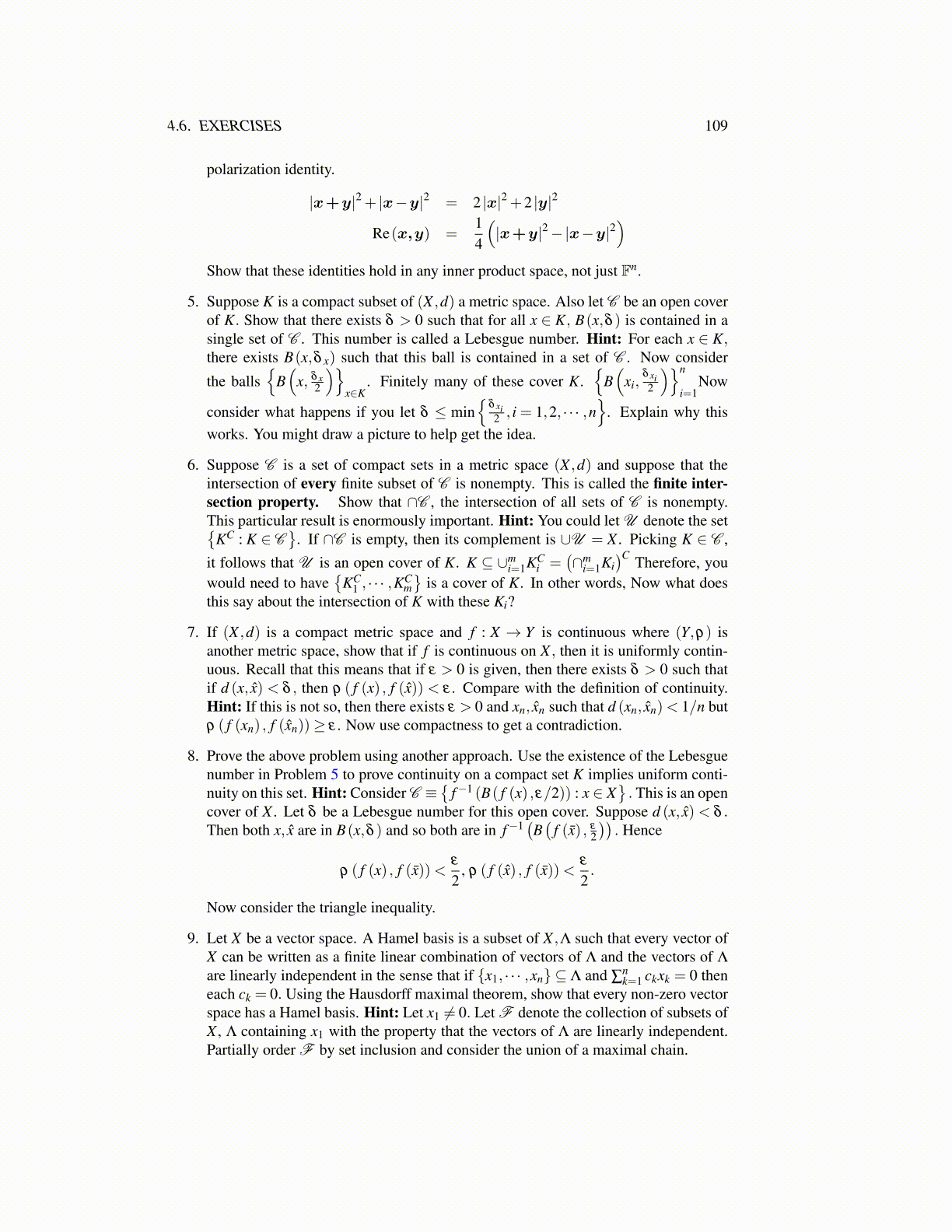
4.6. EXERCISES 109
polarization identity.
|x+y|2 + |x−y|2 = 2 |x|2 +2 |y|2
Re(x,y) =14
(|x+y|2−|x−y|2
)Show that these identities hold in any inner product space, not just Fn.
5. Suppose K is a compact subset of (X ,d) a metric space. Also let C be an open coverof K. Show that there exists δ > 0 such that for all x ∈ K, B(x,δ ) is contained in asingle set of C . This number is called a Lebesgue number. Hint: For each x ∈ K,there exists B(x,δ x) such that this ball is contained in a set of C . Now consider
the balls{
B(
x, δ x2
)}x∈K
. Finitely many of these cover K.{
B(
xi,δ xi2
)}n
i=1Now
consider what happens if you let δ ≤ min{
δ xi2 , i = 1,2, · · · ,n
}. Explain why this
works. You might draw a picture to help get the idea.
6. Suppose C is a set of compact sets in a metric space (X ,d) and suppose that theintersection of every finite subset of C is nonempty. This is called the finite inter-section property. Show that ∩C , the intersection of all sets of C is nonempty.This particular result is enormously important. Hint: You could let U denote the set{
KC : K ∈ C}
. If ∩C is empty, then its complement is ∪U = X . Picking K ∈ C ,
it follows that U is an open cover of K. K ⊆ ∪mi=1KC
i =(∩m
i=1Ki)C Therefore, you
would need to have{
KC1 , · · · ,KC
m}
is a cover of K. In other words, Now what doesthis say about the intersection of K with these Ki?
7. If (X ,d) is a compact metric space and f : X → Y is continuous where (Y,ρ) isanother metric space, show that if f is continuous on X , then it is uniformly contin-uous. Recall that this means that if ε > 0 is given, then there exists δ > 0 such thatif d (x, x̂) < δ , then ρ ( f (x) , f (x̂)) < ε . Compare with the definition of continuity.Hint: If this is not so, then there exists ε > 0 and xn, x̂n such that d (xn, x̂n)< 1/n butρ ( f (xn) , f (x̂n))≥ ε . Now use compactness to get a contradiction.
8. Prove the above problem using another approach. Use the existence of the Lebesguenumber in Problem 5 to prove continuity on a compact set K implies uniform conti-nuity on this set. Hint: Consider C ≡
{f−1 (B( f (x) ,ε/2)) : x ∈ X
}. This is an open
cover of X . Let δ be a Lebesgue number for this open cover. Suppose d (x, x̂) < δ .Then both x, x̂ are in B(x,δ ) and so both are in f−1
(B(
f (x̄) , ε
2
)). Hence
ρ ( f (x) , f (x̄))<ε
2, ρ ( f (x̂) , f (x̄))<
ε
2.
Now consider the triangle inequality.
9. Let X be a vector space. A Hamel basis is a subset of X ,Λ such that every vector ofX can be written as a finite linear combination of vectors of Λ and the vectors of Λ
are linearly independent in the sense that if {x1, · · · ,xn} ⊆ Λ and ∑nk=1 ckxk = 0 then
each ck = 0. Using the Hausdorff maximal theorem, show that every non-zero vectorspace has a Hamel basis. Hint: Let x1 ̸= 0. Let F denote the collection of subsets ofX , Λ containing x1 with the property that the vectors of Λ are linearly independent.Partially order F by set inclusion and consider the union of a maximal chain.